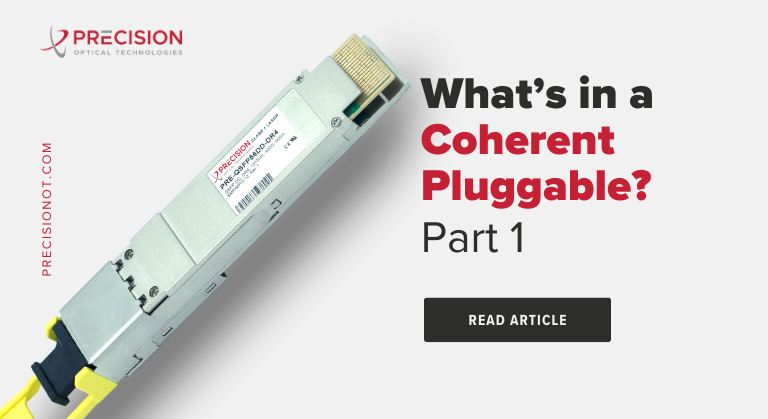
What’s in a Coherent Pluggable? Part I

Coherent pluggable transceivers have transformed optical communications, providing substantial improvements in wavelength capacity, reach and spectral efficiency while also reducing costs per bit and power consumption. But what’s inside these uniquely compact yet powerful devices? Follow along on our 2-part series as we dissect the coherent pluggable…..
Coherent Optical Communication: The Basics
Coherent Optical Communication uses coherent modulation at the transmitting end of a fiber optic link and additional coherent technology at the receiving end for detection. In this technique, both the amplitude and phase of the light waves are modulated to represent digital data, enabling high-speed and long-distance transmission of information. On the receiving end, sophisticated signal processing techniques are used to detect and decode the transmitted signals accurately, even in the presence of noise and distortion. Maintaining a phase reference between the transmitted and received signals enables more precise detection and extraction of information. Coherent communication allows for higher data rates at longer transmission distances and increased spectral efficiency compared to other optical communication methods such as NRZ (non-return-to-zero) or PAM-4 (Pulse Amplitude Modulation – 4 levels).

Figure 1 Coherent Optical Communication Concept
Coherent pluggable transceivers are compact optical modules that integrate coherent optical technology into a form factor that can be easily plugged into switches, routers and other network equipment. The recent advancements in coherent pluggable technology available in QSFP-DD or OSFP form factors deliver increased density when compared to embedded coherent transponders or CFP2 transceivers. Alongside the enhanced density, these pluggable modules also provide higher speeds and extended reach, all while leveraging the flexibility and convenience of hot-swappable, pluggable modules.
Coherent Technology: Modulation Schemes and Standards
Coherent technology revolutionizes optical communication by employing sophisticated modulation and encoding techniques to enhance long reach data transmission over fiber-optic networks. In the context of coherent pluggable standards, these modulation and encoding techniques play a central role in defining the specifications and performance requirements of pluggable transceivers. By adhering to standardized technologies and protocols, coherent pluggable transceivers ensure interoperability, compatibility, and scalability across diverse network environments.
Coherent Modulation Types
A constellation diagram is often used to represent the signal modulated by a digital modulation scheme. It displays the signal as a two-dimensional xy-scatter diagram in the complex plane at symbol sampling instants, as shown below in Figure 2 for NRZ, PAM-4, and QPSK (Quadrature Phase-Shift Keying):

Figure 2 Examples of Non-Coherent and Coherent Modulation Schemes
Non-Coherent optics will typically use simpler modulation schemes such as NRZ or PAM4, while Coherent optics employ more advanced schemes such as QPSK. The advanced modulation techniques used in coherent optical communications leverage the phase and/or amplitude of the optical carrier signal and multiple polarizations. These new formats are essential for achieving high data transmission rates and for improving the spectral efficiency of the optical communication system:
i.) Phase-Shift Keying (PSK) – PSK modulation techniques such as QPSK and 8PSK modulate the carrier signal by changing its phase. QPSK is widely used in coherent optical communication systems, especially in 100G and 200G coherent transceivers. It encodes two bits of digital data per symbol by modulating the phase of the optical carrier signal at four different states, typically separated by 90 degrees. QPSK offers a balance between spectral efficiency and robustness against impairments like chromatic dispersion and polarization mode dispersion.

Figure 3 Constellation Diagrams for QPSK and 8PSK
ii.) Quadrature Amplitude Modulation (QAM) – QAM is a more sophisticated modulation format that combines both phase and amplitude modulation. It allows for the transmission of multiple bits per symbol by modulating both the phase and amplitude of the optical carrier signal. A modulation of 4-QAM would have the same constellation as a QPSK modulation as shown in the image below. Higher order modulations such as 16-QAM, 64-QAM, or even higher, can achieve higher data rates but will require more complicated signal processing and higher signal-to-noise ratio.

Figure 4 Constellation Diagrams for 4-QAM, 8-QAM and 16-QAM
A practical example of a 400G ZR Coherent transceiver using 16QAM modulation without noise (left image) and with added noise (right image) is shown in Figure 5. The noisier the transmission, the harder it will be for the receiver to differentiate between each symbol transmitted and errors will occur.

Figure 5 400G ZR Coherent transceiver constellation diagram example:
16QAM Modulation without noise (left) and with noise (right)
Depending on the transceiver type, data rate, and application, different modulation schemes will be used. Typically, you’ll see the following data rate and modulation schemes paired together:
100G – DP-QPSK
200G – DP- QPSK
300G – DP- 8QAM
400G – DP-16QAM
However, these data rates and applications are not limited to these modulations. For example, an application that uses 400G – DP-8QAM can allow for a longer reach as the Optical SNR requirements will be lower compared to a 400G DP-16QAM.
Another important technique employed in Coherent optics that allows an increase in the data rate (also used in wireless transmissions, for example) is dual-polarization (DP). In dual-polarization techniques the same signal is being transmitted in two orthogonal optical polarizations at an angle of 90 degrees, effectively doubling the amount of data transmitted (see Figure 6). Dual-polarization paired with Coherent technology at the receiver allows the digital polarization demultiplexing and post-processing via DSP (Digital Signal Processing) to recover the information transmitted.

Figure 6 Dual-Polarization Signal
In part II, we’ll discuss error correction techniques, key industry standards, and the interior anatomy of coherent pluggables. You can view that blog here! For more information about coherent and other optics, check out our offerings or contact our expert staff with any questions!






